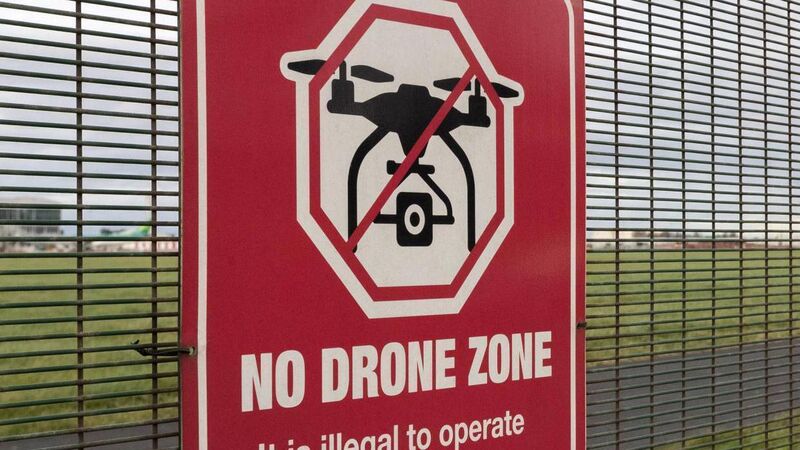Drone problem is not new... it’s been on the radar since 2017

'No Drone Zone' signs on the fence at Dublin Airport. Picture Colin Keegan, Collins Dublin
Sure, the poor man must be exhausted. Maybe that’s why he’s appeared to be asleep at the wheel on the drone issue.
I always liked Michael O’Leary. How could you not like that caustic wit which shoots straight from the hip into the heart of the matter, no matter how serious?
Never a man to suffer fools gladly, the Ryanair CEO, I felt, showed uncharacteristic restraint about the fact that it has taken the best part of six years for the government to decide which kind of anti-drone technology it was going to buy to deal with ongoing disruptions at Dublin airport. It was only when the protests over the ongoing disruption of flights reached ear-splitting levels and an exasperated O’Leary called for his resignation that the Minister for Transport and Green Party head honcho appeared to wake up about the necessity to actually do something about all of this.
The aviation business, he said, couldn’t comprehend why the minister wasn’t acting on the issue. It was a case for Eamon Ryan to either deal with the issue, or resign, he said.
The government finally - and only, I’d say as a result of massive pressure from the aviation and business sectors, pilots, opposition politicians, the media and the biting observations of O’Leary - got around to deciding what kind of anti-drone technology it was going to use to counteract the disruptions. Then the minister has turned around and declared that it will take weeks to get it all up and running. Weeks, he said. On top of an investigation that took the guts of six years.
The Green Party has loyally argued that the Minister’s department had been assessing the legislative framework and the appropriate technology “since the problems first started to emerge”. Pause for a minute there. The problems started to emerge in 2017. Yep. 2017.
Yet Michael O’Leary, who has spent his career in aviation, says the solution to the illegal drone activity is “relatively easy”. He could probably have told them long ago what to buy and where to buy it. So why didn’t they ask him? Haven’t they heard of cutting off the head of the snake, nipping problems in the bud or putting the kybosh on something?
What are they using up there at Transport HQ to carry out their investigations? Stone carvings? Hand-written letters? Paper library archives? Because the technology, they’re now thinking about buying – which disables drones by blocking the signals – has reportedly been in use at Heathrow for three years or more.
All of this is not just a matter of drones delaying a few retirees en route to a spring break in Lanzarote. Drones - as aviation experts have repeatedly warned - are extremely dangerous things. A drone can destroy the engine of a jet in seconds. If one of these things is sucked into the engine of a jet it can cause massive damage - far more than a bird strike, because, after all, the drone is made of metal or plastic and contains high-capacity batteries. Just as scary is the fact a drone can penetrate the windscreen of a cockpit – killing the pilots while the plane (full of passengers) is airborne. These things are not toys, boys.
Plus, the ongoing drone disruption at Dublin Airport is a significant problem for Ireland’s economy as it affects the business sector. As a prominent businessman has warned, Ireland is but a small island located alongside “some very big global markets” and we really depend on an excellent transport network. The Dublin-London air route, it has been pointed out – and surely the Department of Transport should know and prioritise this - has for years been “the second busiest in the world”. Did you know that? I didn’t.
John McGrane of the British Irish Chamber of Commerce has described the delay in stopping the drones as “deeply alarming.”
The failure by the government to get its skates on regarding the issue will not have gone unnoticed by Ireland’s trading partners abroad. Ireland’s perceived laxity in terms of prioritising Ireland’s international business relationships is already a cause for major concern. Tell me this. How many more red flags will the aviation and business sectors have to wave around before Minister Ryan gets this technology working and puts an end to all the carry-on?







 App?
App?




